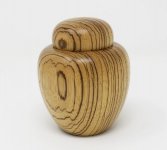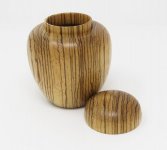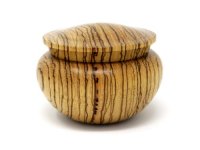Mike Stafford
Member
- Messages
- 2,352
- Location
- Coastal plain of North Carolina
I've had this piece of zebrawood collecting dust for quite a while. It was left from a much larger stick from which I made several boxes. I decided that I would use it whole and make a ginger jar.
Ginger jars were originally designed by the Chinese to hold and protect spices. Well, you don't want to put any spices in this stinky zebrawood ginger jar. If you haven't turned zebrawood you are not in for a treat. It smells like a wet dog and to further isolate the origin of the smell it comes from just under the tail joint.
Anyway, you get my drift. This ginger jar is about 6" tall. The grain in this wood is very straight and rewards the turner with an almost perfect grain alignment between body and lid when assembled.


Ginger jars were originally designed by the Chinese to hold and protect spices. Well, you don't want to put any spices in this stinky zebrawood ginger jar. If you haven't turned zebrawood you are not in for a treat. It smells like a wet dog and to further isolate the origin of the smell it comes from just under the tail joint.
Anyway, you get my drift. This ginger jar is about 6" tall. The grain in this wood is very straight and rewards the turner with an almost perfect grain alignment between body and lid when assembled.






